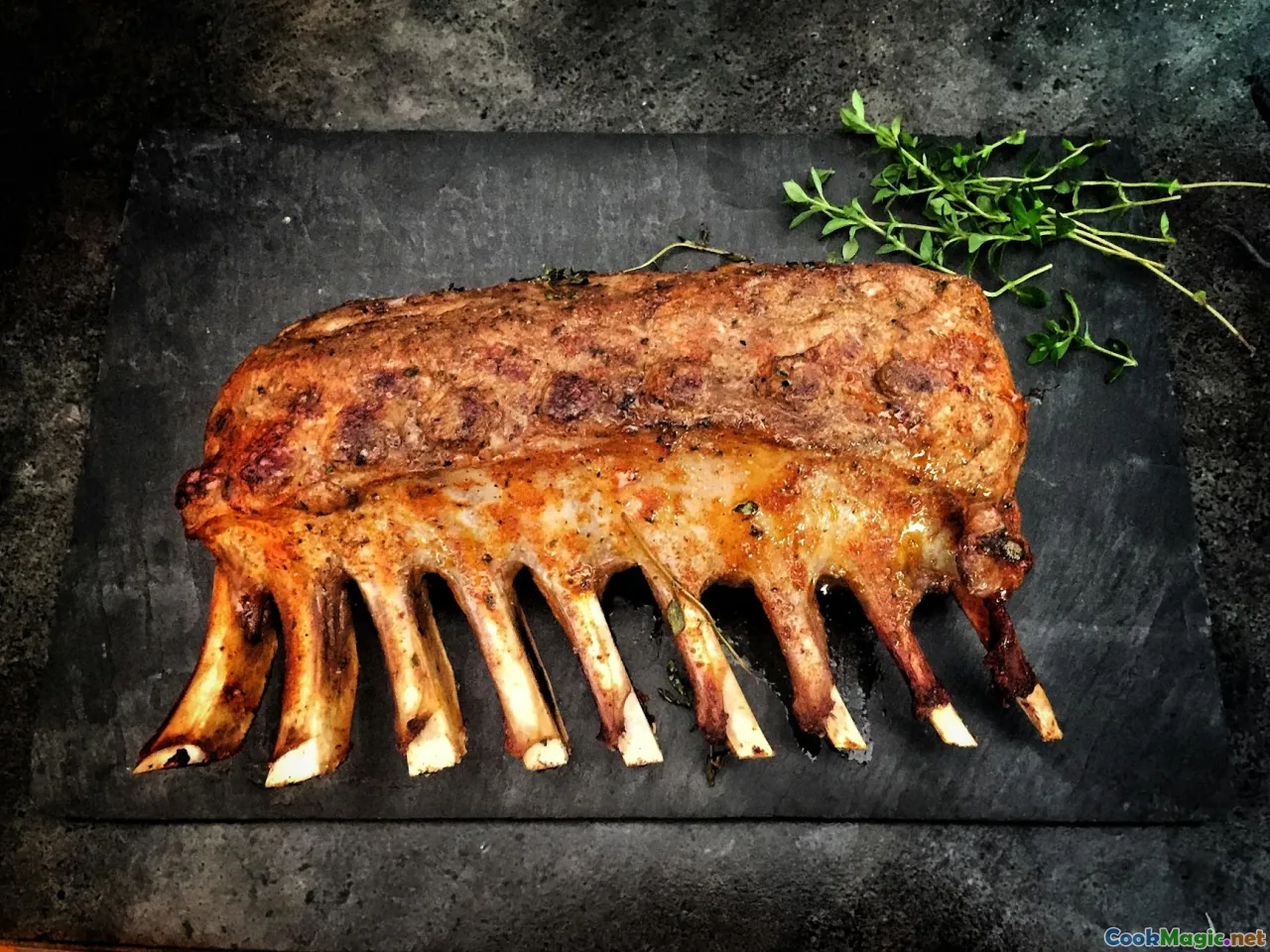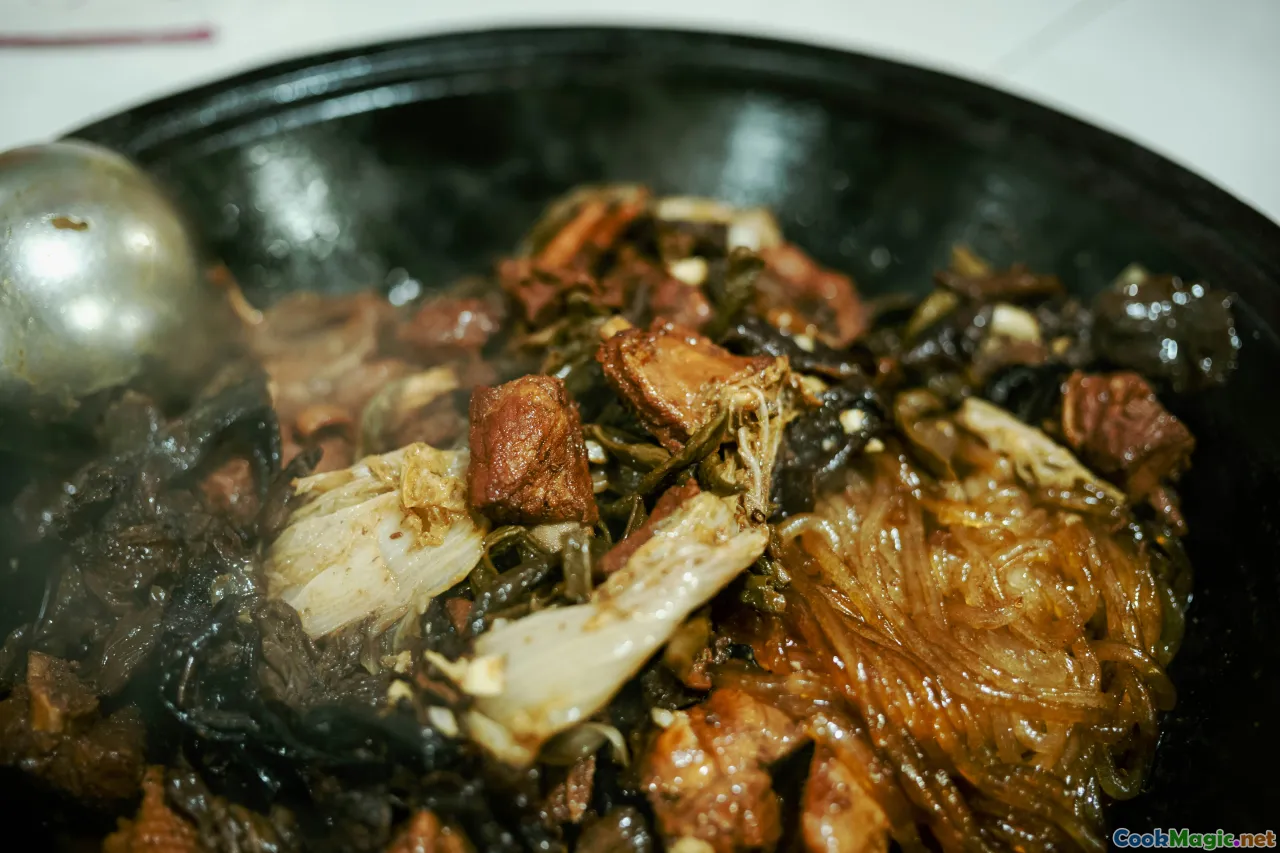
那加兰熏猪肉 Axone:发酵的纳加特色美食
(Nagaland Smoked Pork Axone: Fermented Naga Delicacy)
(0 评论)食材
-
600 grams 熏猪五花肉
(Traditionally smoked over wood fire for aroma)
-
100 grams Axone(发酵大豆)
(Can use homemade or storebought paste)
-
15 pieces 印度红干辣椒
(Use Naga mircha for extra heat)
-
8 pieces 青葱
(Small purple onions, finely sliced)
-
2 tablespoons 新鲜姜根
(切得很细)
-
6 pieces 大蒜瓣
(Crushed or chopped)
-
80 grams 竹笋
(Ideally fermented, rinsed and sliced)
-
2 medium 番茄
(切碎)
-
1 teaspoon 研磨姜黄粉
(色泽与风味)
-
1 to taste 盐
(根据需要调整)
-
1 liter 水
(As needed for simmering)
-
2 tablespoons 芥末油
(Adds authentic pungency)
-
2 tablespoons 青芫荽叶
(切碎,用于装饰)
(Traditionally smoked over wood fire for aroma)
(Can use homemade or storebought paste)
(Use Naga mircha for extra heat)
(Small purple onions, finely sliced)
(切得很细)
(Crushed or chopped)
(Ideally fermented, rinsed and sliced)
(切碎)
(色泽与风味)
(根据需要调整)
(As needed for simmering)
(Adds authentic pungency)
(切碎,用于装饰)
营养
- 份量: 4
- 每份大小: 1 碗 (250克)
- Calories: 830 kcal
- Carbohydrates: 14 g
- Protein: 29 g
- Fat: 71 g
- Fiber: 4 g
- Sugar: 3 g
- Sodium: 950 mg
- Cholesterol: 165 mg
- Calcium: 74 mg
- Iron: 3.2 mg
制作步骤
-
1 - Prepare Pork & Axone:
Cut the smoked pork belly into thick bite-sized cubes. Rinse axone briefly to mellow its pungency and crush into a coarse paste.
-
2 - Soften Chilies:
Soak dry chilies in hot water for 5 minutes, then drain and blend with ginger, garlic, and a dash of water into a rough paste.
-
3 - Sauté the Aromatics:
Heat mustard oil in a heavy pot (if using). Sauté shallots until soft, then add chili-ginger-garlic paste and sauté till fragrant.
-
4 - Add Pork and Flavorings:
Add pork pieces and cook, turning, until lightly browned on the edges. Mix in turmeric, salt, axone paste, and optionally bamboo shoots and tomatoes.
-
5 - Simmer Stew:
Pour in water to cover, bring to a boil, then reduce heat and simmer uncovered until pork is very tender and flavors meld (about 60–75 minutes). Adjust salt as needed.
-
6 - Garnish & Serve:
Stir well, skim any fat from the surface, and garnish with fresh coriander leaves. Serve hot with steamed rice.
Cut the smoked pork belly into thick bite-sized cubes. Rinse axone briefly to mellow its pungency and crush into a coarse paste.
Soak dry chilies in hot water for 5 minutes, then drain and blend with ginger, garlic, and a dash of water into a rough paste.
Heat mustard oil in a heavy pot (if using). Sauté shallots until soft, then add chili-ginger-garlic paste and sauté till fragrant.
Add pork pieces and cook, turning, until lightly browned on the edges. Mix in turmeric, salt, axone paste, and optionally bamboo shoots and tomatoes.
Pour in water to cover, bring to a boil, then reduce heat and simmer uncovered until pork is very tender and flavors meld (about 60–75 minutes). Adjust salt as needed.
Stir well, skim any fat from the surface, and garnish with fresh coriander leaves. Serve hot with steamed rice.
关于 那加兰熏猪肉 Axone:发酵的纳加特色美食 :的更多信息
Nagaland Smoked Pork Axone: The Soul of Naga Cuisine
Smoked Pork Axone, locally beloved in the Naga hills, is a robust stew that brings together two iconic Nagaland ingredients: smoky, rustic pork and incredibly fragrant, fermented axone (pronounced "akhuni"). Axone is made from soybeans that have been traditionally fermented, wrapped, and dried, delivering a distinctive aroma and a deep, umami-laden earthiness that distinguishes Naga cooking from much of the rest of India. It sometimes puzzles unfamiliar noses but fascinates adventurous eaters, enveloping the dish in a unique flavor not easily found elsewhere.
The Story Behind the Dish
This recipe hails from the kitchens of the Angami Naga and other Naga tribes, whose homes circle the mountainous, mist-shrouded terrain of northeast India. The techniques passed from elders to cooks: pork, from swine raised carefully on fodder and forest gleanings, is first smoked (often on bamboo racks above a wood cookfire) for preservation. The axone manufacture itself is a labor-intensive task–boiled soy beans are placed in wild banana leaves or baskets to ferment, after which they're sun-dried. This ancestral knowledge means the dish isn’t sustainably reproduced outside the region without some improvisation.
How It Is Served
The classic serving style is family-style, in deep bowls accompanied only by sticky steamed rice and perhaps a mild, leafy vegetable. Each family tends to their version: some add bamboo shoots for award-winning tartness and texture, or brighten with whole tomatoes; others keep the base ultra-simple to show off the intoxicating depths of the smoked pork and axone. For a truly fiery feast, the locally loved raja mircha (Naga Ghost Pepper) or red chilies are pounded into the stew, blessing it with brilliant heat that's as enduring as it is electrifying.
Cooking & Substitution Tips
- If you can’t find authentic Naga-smoked pork, use any naturally wood-smoked uncured belly or even smoked bacon, but reduce added salt as bacon is generally saltier.
- Axone is now exported as a paste, canned or even dried form. Those averse to strong-smelling ferments might rinse briefly in water to moderate aroma before cooking. Always be aware of lingering stronger smells as it matures.
- Local bamboo shoots are best, but vacuum-packed Asian store shoots can be used after rinsing. Bamboo adds grassiness and a unique flavor. Leave it out if unavailable.
- Mustard oil gives complexity and spice but can be swapped for a neutral oil in a pinch, though the flavor will shift.
Cultural Notes & Distinctiveness
Pork dominates Naga feasts for celebratory dishes and ordinary meals alike. Smoked pork axone finds a regular place at winter gatherings, where well-smoked flesh and fermented beans helped ancient Nagas store and survive through harsh terrains and periods of self-reliance. Beyond nutrition, Axone (and the dishes made with it) form a symbol of community pride–neighboring villages even rival one another for the best product, with particular months and techniques yielding subtle differences in taste.
The spicy, oily stews suit the cool climate, and the hearty broth offers both comfort and sustenance. The fermentation process not only aids nutrition but adds impressive levels of plant-based protein, vitamins, and beneficial bacteria. Eating axone is growing in interest among health-conscious eaters worldwide for its probiotic benefits–well before today's trend.
Today, serving this dish outside of Nagaland, you bring a story: a taste of tribal India, brilliantly bold, layered with ancient methods of preservation, interwoven with traditions as enduring (and as deep) as the flavors themselves. Whether first-timer or Naga at heart, Nagaland Smoked Pork Axone invites both challenge and reward to those who cook, share, and taste it.
Try this once, and your kitchen never smells the same—it's a culinary journey into the heartland of India mystique.

























